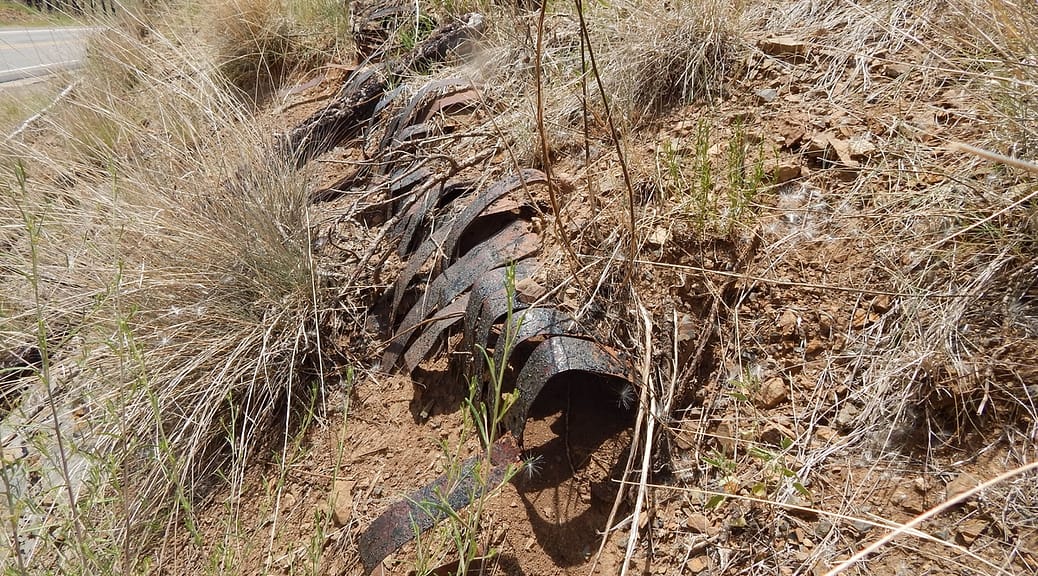
Bonito Pipeline Rising
 Properties nominated to the National Register need not be a building, district, monument or archaeological site. Structures that are used for purposes other than shelter are also considered. Such is the case in Lincoln County where the El Paso and Southwestern Railway Water Supply System, otherwise known as the Bonito Pipeline, was approved for the National Register of Historic Places in 1979.
Properties nominated to the National Register need not be a building, district, monument or archaeological site. Structures that are used for purposes other than shelter are also considered. Such is the case in Lincoln County where the El Paso and Southwestern Railway Water Supply System, otherwise known as the Bonito Pipeline, was approved for the National Register of Historic Places in 1979.
The nomination, prepared by Willian L. Cumiford of the history of engineering program at Texas Tech and available online at http://npgallery.nps.gov/nrhp/SearchResults/, includes a physical description and detailed history of the pipeline. Its time of significance is listed at 1908 and 1914 and its significance is in the areas of agriculture and transportation.
The railroad was desperate for water for its boilers as it planned routes through Carrizozo, but there were no large bodies of water or perennial streams from which to draw. Wells were drilled near the railyards and along the proposed route from El Paso to Tucumcari beginning in 1901. The better water was from the Carrizozo area, but it was not ideal. It was not potable and caused scaling, deterioration of the boiler tubes and even engine failure and itsuse resulted in repairs, “…excessive overtime, and a demoralized train service.”
In 1908, surface water from the South Fork of the Rio Bonito was tapped as a viable water source. A small dam was constructed on the stream and a pipeline was built to the man-made Nogal Lake. Over 400 million gallons could be stored at the lake but it was plagued by leakage. Cattle were used to trample the ground to compress the ground. It took over 300 cattle over 11,000 cattle-days to reduce the leakage and to provide a suitable base for the lake.
From Nogal, the water traveled north 53 miles to Coyote with a branch line into Carrizozo. At the time it was the longest pipeline in New Mexico. A continuation of the line to Pastura, another 54 miles, was completed in 1914.
A ditch was cut to receive the pipe. Over a hundred braceros (Mexican guest workers) dug down ten to 35 feet with picks and shovels and wagons from Mogollon moved the pipe into place. At the end of the day, a large tent was erected for the workers and meals were eaten in a separate mess tent. A railroad commissary also traveled the route from which the workers were expected to buy supplies, including the required gloves and working clothes. Rent for the tents was also paid at the commissary. Several men suffered from illness and exposure and some died from inadequate medical attention. According to the nomination, their wages were $1.75 a day.
The pipeline itself was constructed with white pine slats first wrapped by flat steel and later quarter-inch wire. The wire was able to be wrapped tighter than the flat bands, resulting in a stronger pipe and less leakage. Sections of pipe, which varied in diameter from 3.5 to 16 inches, were rolled in asphalt and then sawdust before being transported. The sections were coupled on-site by a bell-and-spigot joint that was packed with braided hemp and heated to seal it before being lowered into the ditch and then covered by dirt.
Pumps were used at Coyote (elevation 3,500 feet) and Luna to push the water uphill to Corona (elevation 6,700). From a reservoir in Corona, gravity allowed the water to flow into Pastura.
Unfortunately, leakage problems at Nogal Lake continued, and it could be counted on to hold only 163 versus the original 422 gallons of water. Southern Pacific Railroad took over the railroad lines and built a dam to create Bonito Lake in 1931, making Nogal Lake obsolete. The final blow to the railroad’s use of the water supply came as diesel locomotives became the standard. In 1955 permission was granted by the New Mexico State Engineer to transfer 470 million gallons a year to the United States government for water to be diverted to what was then called the Holloman Development Center. In 1957 a new pipeline made of iron was begun that followed the original line before continuing on to Carrizozo and then Alamogordo.
Before the Little Bear fire, the wooden slats of the original pipeline could be seen jutting out of the roadside banks just north of the Bonito Lake turnoff on Highway 37. Now just the rusted flat metal bands can be seen, crumpled and resembling the ribcage of a long, round creature making its way to a dry Nogal Lake.